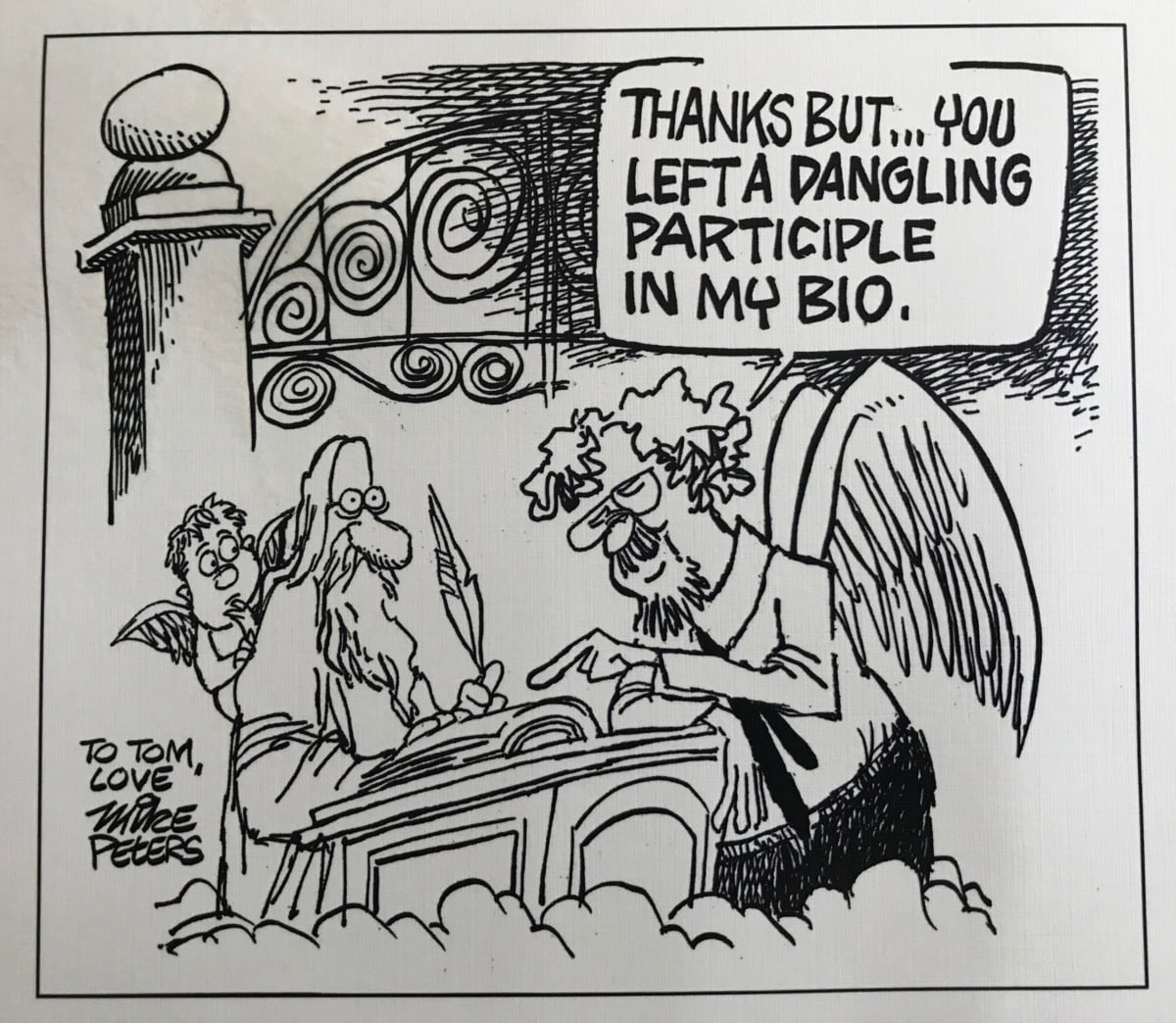
- Select a language for the TTS:
- UK English Female
- UK English Male
- US English Female
- US English Male
- Australian Female
- Australian Male
- Language selected: (auto detect) - EN
Play all audios:
By Maria Saporta Friends, colleagues and family gathered at the Mason Art Gallery Sunday afternoon to remember one of Atlanta’s unapologetic liberals – Tom Teepen. Teepen, editorial page
editor of the Dayton Daily News, became an Atlantan when he joined the Atlanta Constitution’s editorial page in 1982, soon becoming its editor. He later served as a syndicated political
columnist for Cox Enterprises until he retired in 2002. Sunday’s gathering was a “A Celebration of Life” for Tom Teepen (Jan. 19, 1935 to April 16, 2017) – and an opportunity for people to
share memories of Teepen. The event was put together by Sandy Teepen, his wife of more than 40 years. Also present were his two children from his previous marriage – Kristina Teepen Garcia
and Jeremy Roux Teepen, his wife, and four of their six children. Even his first wife, Nancy Roux Teepen, came saying it was important for her to be there because he was the father of her
two children. Just as important in his life was Jenni Koerlin-Fearn, Sandy Teepen’s daughter from her previous marriage. “Tom was the best father I could ask for,” Koerlin-Fearn said. “Tom
was articulate, liberal-minded, a brilliant writer and well-read in all things politics, history and music.One of his finest qualities was his patience and inherent ability to also listen
absorb and to offer a point of view based on a quiet measured wisdom.” Fellow editorial writer Joe Geshwiler recalled Teepen as a writer who seemed to know exactly what he wanted to say.”
And as Geshwiler became more confident in writing editorials, he said: “Tom became an inspiration to me.” The gathering, as chronicled by Susan Ross, attracted colleagues from Dayton, Ohio
as well as Atlanta. Editorial cartoonist Mike Luckovich was joined by his fellow Pulitzer Prize winning editorial cartoonist Mike Peters, who drew the sketch on the front and the back of the
program. Peters described Teepen as an “amazing boss” and an “amazing person,” who would write editorials with a sense of humor. While he liked writing editorials, Teepen really did not
enjoy being a boss, and Peters tested Teepen’s patience for 13 years. “I would come in with my cartoon to show Tom,” Peters remembered. If Teepen took longer than 3 seconds to respond,
Peters knew he had fallen short. “He’d look up at me and say: ‘You can do better,’” Peters recalled. “He didn’t say: ‘This is shit.’ He taught me I could do better.” So when it came time to
draw the caricature for the Celebration program, Peters said he must have drawn it about 50 times, hearing Teepen saying he could do better. (Peters privately shared his own way of knowing
whether a cartoon worked. He told me he takes the sketch, turns it backwards and holds the paper to the light. The sketch does not pass his test unless it looks good backwards and forwards.
Luckovich then shared his own trick. He lets the sketch sit for 10 minutes or half an hour, and then he comes back and looks at it and can “immediately see what’s wrong with it.” To that,
Peters said Ernest Hemingway wrote “The Old Man and the Sea,” and put it away for a year. When he picked it back up, he was able to find the parts that worked and rewrite the passages that
didn’t. It’s so nice to be around creative people who share how they master their craft.) The Celebration was full of artists, writers, musicians, activists, spiritual advisors and people
who still believed they could change the world.” Son-in-law Bill Garcia shared that he was a Republican when he became part of the family 25 years ago. “Over the years, my political views
have shifted 180 degrees,” Garcia said, adding that he admired “Tom’s conviction.” And he saw how Teepen’s skin developed a thickness as critics would write him notes that said: “Tom Teepen,
go back to Ohio.” Jay Smith, the former publisher of the Atlanta Journal-Constitution, remembered when they worked together in Dayton as well as Atlanta. Smith and his predecessor, David
Easterly, described Teepen as someone who wrote opinion, but it was opinion based on facts. “Tom spoke the truth,” Smith said. “He spoke the truth to this community” even when the community
didn’t want to hear it. Case in point, I remembered when Teepen wrote an editorial in 1987 saying it was time to change the Georgia flag and remove the Confederate symbol, which he said was
neither historic or honorable. The reaction to that column was fierce – with many Georgians (both in the newsroom and throughout the state) questioning why this outsider from Ohio was
telling them to change the flag. (Below are two of his Atlanta Constitution/AJC editorials urging to change the Georgia flag – printed in full). Obviously Teepen was right. But it took
another 14 years for Georgia’s mindset to catch up with Teepen’s sentiments. Gov. Roy Barnes changed the flag in January 2001, one of the reasons he lost his re-election a year later. But
one thing was clear. Teepen was a man ahead of his time – someone who set a high bar for Atlanta, Georgia and the nation. And that is worth celebrating. LET’S MODERNIZE THE STATE’S FLAG By
Tom Teepen, editor of the Atlanta Constitution _Published on February 7, 1987_ The network television series “Matlock” stars Andy Griffith as an attorney and Atlanta as, well, Atlanta. And
the city looks pretty good, too, our downtown modern, bustling and appealing. But then lawyer Andy goes to court – and the whole effect falls apart. There hangs the old Confederate battle
flag. So much for Atlanta, the international city of the future. So much, for that matter, for the vaunted New South. Of course, the flag is not exactly the Confederate one, but rather the
Georgia state flag, some two-thirds of which is taken up by the old battle flag. Let’s face it: We ought to change the state flag. Alas, it is neither historic nor is its design honorable.
Georgia had a perfectly presentable flag until 1956, a fairly plain affair featuring the state seal. But in 1954, the U.S. Supreme Court ruled against racially segregated schools; in 1955
several members of the Georgia Legislature proposed changing the state flag in order to incorporate the Confederate flag, and in the next year the deed was done. There was no public clamor
for the change. In fact, the move was opposed at the time by a number of historical organizations, including the United Daughters of the Confederacy and the Sons of Confederate Veterans. The
push was entirely political. The Confederate battle flag was dragooned into the service of lawmakers who were practicing the demagogic politics of defiance and vowing to preserve
segregation. A flag that had flown over the personal honor and courage of men who fought under it was pressed on the state flag in an act of shabby politics. To say that the flag adopted in
1956 is inappropriate to modern Georgia is to put the matter mildly indeed. The flag preserves what was a passing moment in the state’s political history, and it imposes on a current
generation whose aims and acts are strikingly different It is all very well to argue that the Confederate battle flag had an honorable history. But the brute truth of the current situation
is quite different. The flag has long since been taken up as a symbol of racism. It illustrates the “Fergit, Hell!” bumper stickers and shares pickup-truck windows with slogans that no one
could misread as progressive (or even as postdiluvian). It was not by mere coincidence that in the two brotherhood marches in Forsyth County, the marchers walked under the American flag and
the Ku Klux Klan and its yahooing sympathizers were all a-flutter with Confederate flags. It may not be so with everyone in the South, but in the rest of the nation, just about everyone
recognizes the Confederate battle flag as a symbol of racism and racist defiance, and this is one instance in which others see us more clearly than we see ourselves. The current state flag
is an insult to the one-third of the state’s population that is black and a misrepresentation of most of the two-thirds that is white. Georgia, with the pragmatism that is typical of it in
most times, has long since moved beyond the sour passions that were being incited when the state Legislature adopted a new flag in 1956. Whatever it stood for in the last century, the
Confederate battle flag now stands for the Jim Crow South. The 2,000 delegates of the United Methodist Conference in Spartanburg, S.C., recognized as much last year when they passed a
resolution urging that the Confederate flag no longer be flown over the state Capitol. A conference spokesman said, “People realized . . . the Confederate flag has become a symbol of
oppression for a portion of our conference members.” The historic flag’s reduction to such degraded duty was the work in part of the Georgia Legislature itself, when it misused the flag to
send just that message. Modern Georgians deserve a flag of their own. _Teepen__ is editor of The Constitution’s editorial page. _ FLAG FLAP REKINDLES OLD SOUTH _Published on __January 17,
1993_ The Atlanta Journal and The Atlanta Constitution By Tom Teepen The South is embarrassing itself publicly again. Just when you think the New South is all set – a gloss of skyscrapers
and canny businesses – the Old rises again, like something undead in a Stephen King novel. It is rising now in mock-historic defense of the Confederate battle flag, the ensign of choice for
the region’s racists and yahoos for 100 years. The flag’s official role is at political issue, in varying degrees, in four states. And the only history that any of this has anything to do
with is the history of racism. In Georgia, progressive Gov. Zell Miller is urging the state Legislature to retire a state flag in which the Confederate battle flag plays the dominant design
role. But the lawmakers resist, and defensive billboards have been thrown up by the Sons of Confederate Veterans, the wing of the “Fergit, Hell!” crowd that owns ties. The flag is likely to
fly a few years longer in Georgia. In Alabama, black legislators convicted of trespassing four years ago for trying to haul down the battle flag at the state Capitol finally have a friend in
court. A judge has invoked an obscure 19th-century law saying that only the national and state flags can be flown over the Capitol. Sensible politicians would see that as a way out –
grumbling every step, if they feel they must for the throwbacks. But, no, several legislators vow to repeal the law or overwhelm it with a state constitutional referendum. Alabama Gov. Guy
Hunt eggs them on. (He is under indictment for some political-fund fiddles and knows a refuge for scoundrels when he sees one.) South Carolina, too, flies the battle flag, and Mississippi,
like Georgia, incorporates it into the state flag. Efforts to change those policies flopped in recent years. Dutiful legislation is likely in both states again this year, though another
strong push probably isn’t imminent in either. The resistance only postpones the inevitable, dragging out a painful notoriety for the region that works to its social and economic loss, as
many know full well. Alabama’s chambers of commerce have pleaded that the flag be kept off the Capitol. Defenders go into flights of oratory about honor, valor, brave boys and the righteous
demands of history whenever the Confederate battle flag is challenged. It’s all a lie. South Carolina started flying the flag only in 1962 as a part of its resistance to school integration.
Alabama’s racist Gov. George C. Wallace had it first hoisted after his appalling “segregation forever” speech the next year. Georgia dropped its historic flag in favor of the battle-flag
design in 1956, during a legislative session marked by fury at the Supreme Court ruling ending school segregation. Mississippi’s flag was adopted in the 1890s as the symbol of Jim Crow
segregation then being enacted under a new state constitution. In every instance that the Confederate battle flag was taken up officially, it was taken up not to honor historical memory but
as a pointed act of racist defiance. It may have had an honorable history in battle, but it has never had an honorable moment in politics. _Tom__ __Teepen__ is national columnist for Cox
Newspapers. He is based in Atlanta. _ _RELATED POSTS_








